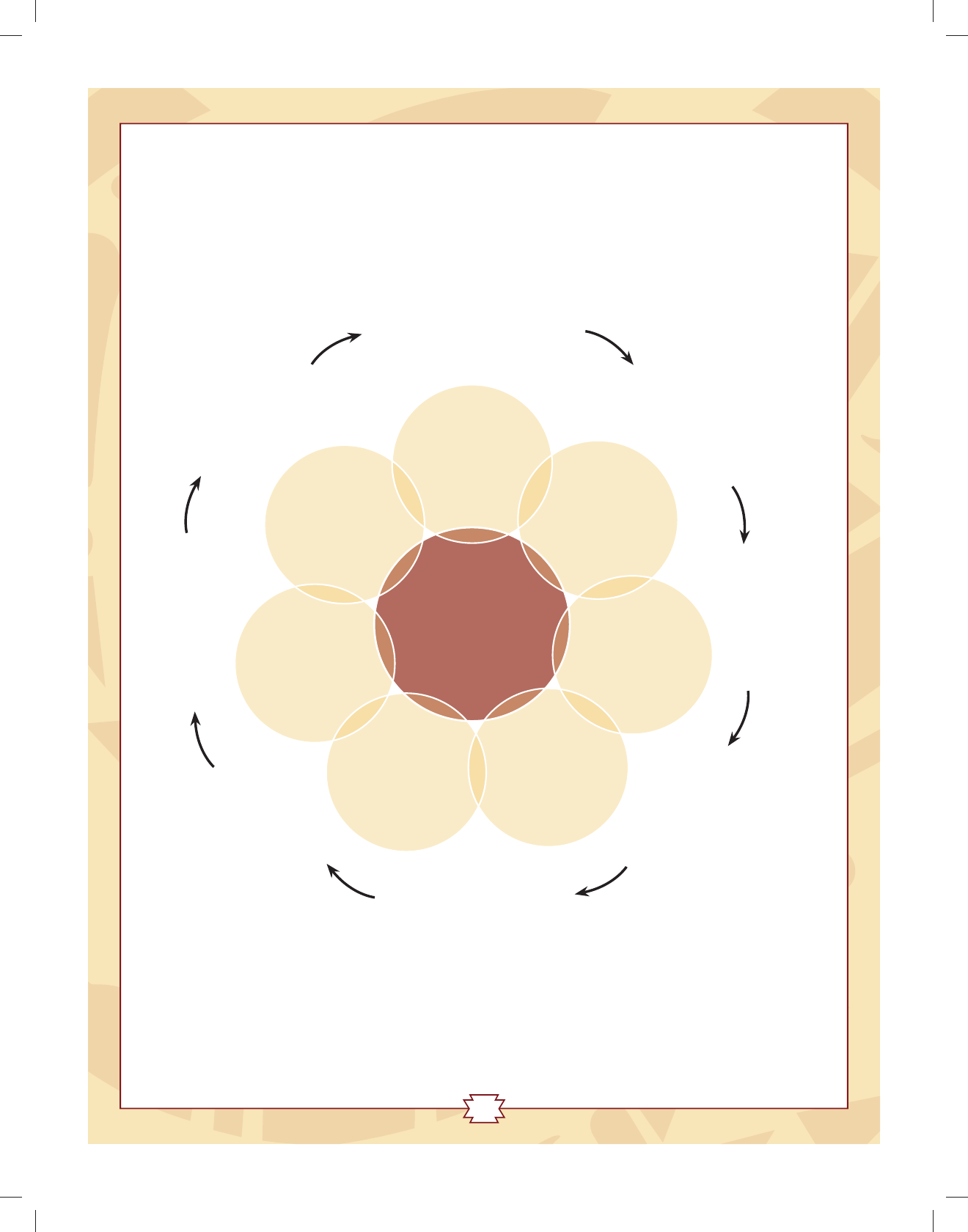
GUIDING PRINCIPLES FOR
ENGAGING IN RESEARCH WITH NATIVE
AMERICAN COMMUNITIES
A Collaborative Effort By:
UNM Department of Psychiatry Center for Rural and Community Behavioral Health t Albuquerque Area Southwest Tribal Epidemiology Center
UNM’s Prevention Research Center
t New Mexico Tribal Strategic Prevention Framework Project
Nadine Tafoya and Associates t
Pacific Institute for Research and Evaluation
Guiding_Principles_v1.indd 1Guiding_Principles_v1.indd 1 8/14/12 1:21 PM8/14/12 1:21 PM

2
Table of Contents
Introduction 3
Guiding Principles
Principle 1: Native Centered 5
Principle 2: Respect 6
Principle 3: Self-Refl ection and Cultural Humility 7
Principle 4: Authentic Relationships 8
Principle 5: Honor Community Time Frames 9
Principle 6: Build on Strengths 10
Principle 7: Co-learning and Ownership 11
Principle 8: Continual Dialogue 12
Principle 9: Transparency and Accountability 13
Principle 10: Integrity 14
Principle 11: Community Relevance 15
Guiding Principles Visual Reference 16
Resources 17
Suggested Citation: Straits, K.J.E., Bird, D.M., Tsinajinnie, E., Espinoza, J., Goodkind, J., Spencer, O.,
Tafoya, N., Willging, C. & the Guiding Principles Workgroup (2012). Guiding Principles for Engaging
in Research with Native American Communities, Version 1. UNM Center for Rural and Community
Behavioral Health & Albuquerque Area Southwest Tribal Epidemiology Center.
Guiding_Principles_v1.indd 2Guiding_Principles_v1.indd 2 8/14/12 1:21 PM8/14/12 1:21 PM

3
Introduction
This document is intended for use by researchers, both non-Native and Native,
working with Native American peoples and their respective communities.
In response to past injustices, research to promote individual, family, and community
health requires attention to issues of social justice and the distribution of resources.
Thus, engaging in research with Native American communities warrants a careful
review of principles that can help investigators to be more aware of Native-specifi c
issues (e.g. cultural values, diversity, appropriate protocols and approval processes),
and conscientious in their interactions with Native partners throughout the research
process. Until recent decades, Native American people have had little or no
representation in the research process.
This document was developed by a multi-ethnic group of researchers and community
consultants, including individuals who are also active tribal members, to:
1) provide written guidance when encountering challenges in research
relationships and processes;
2) elicit thoughtful discussion among researchers, and;
3) increase awareness of our responsibilities as investigators not only to the
individuals participating in research but also to the communities.
The reader should note that this document is limited in its ability to convey the
amount of time and effort it takes to get to a place of understanding and knowing
a community even before the research process begins. Additionally, research in
partnership with one Native American community does not necessarily translate
to processes or procedures needed in another community, thus highlighting the
uniqueness of each tribal nation. We intend for this to be a living document
1
that
can be adapted and refi ned as new approaches to research are developed and as
institutions and researchers confront diverse situations.
1
If you have a vignette arising from personal experience that illustrates the importance of one or all of the
principles, we request that you submit your vignette to Doreen Bird, MPH at [email protected] for
inclusion in future versions of this document. Please be sure to include your contact information.
Guiding_Principles_v1.indd 3Guiding_Principles_v1.indd 3 8/14/12 1:21 PM8/14/12 1:21 PM

4
Defi nitions
For the purposes of this document, the following defi nitions are used:
Culture: Culture and traditions vary greatly between Native American communities.
Native American individuals and communities also vary in adherence to their
cultures of origin and to Western cultural values and beliefs. For many Native
American people, spirituality and religion are generally perceived as an integral
aspect of culture. Spirituality also takes on many forms within Native American
communities, from use of traditional Indigenous practices to Christian beliefs.
Cultural humility
1
: A commitment and active engagement of continual self-
evaluation regarding the interaction and impact of one’s culture(s) on a given
situation or relationship so as to cultivate mutually benefi cial partnerships that
recognize and remedy any power imbalances.
Community: There is no single defi nition of community that applies to every
situation. This term can be co-defi ned with partners in the research process.
For example, a Native American community could refer to an entire tribe, smaller
groups within the tribe, an urban Indian community composed of individuals from
different tribes, or the larger Native American community within a city, state,
country, or the globe.
Native American: A member of any of the Indigenous peoples of the Americas.
We recognize that there are a number of other preferred terms. We also recognize
that there are native peoples outside of the United States, but for the purposes of this
document, we refer to Indigenous peoples of, or residing in, the United States when
we use the term Native American.
Non-Native: An individual who is not a member of the Indigenous peoples of the
Americas.We recognize the diverse histories of researchers of different races. We
have selected this general term to increase the applicability of this document to
researchers of all races/ethnicities not of Native American descent or heritage.
This encourages the reader to consider differences in historical experiences,
assumptions and stereotypes.
Tribal Sovereignty: “Sovereignty” is the authority of a state or nation to govern
itself. Tribal sovereignty in the United States of America provides federally
recognized Indigenous tribes the inherent authority for self-governance. However,
the federal government recognizes tribes as “domestic, dependent nations,” meaning
that they have local sovereignty, but not full sovereignty as other nations in the
world. Thus, many Native American communities in the USA are, or belong to
locally sovereign nations, and thus, have their own governance, laws, and leaders
that function independently.
1
This term was presented at the University of New Mexico Master of Public Health 2011 Community Based
Participatory Research Summer Institute, facilitated by Dr. Nina Wallerstein and Dr. Tassy Parker.
Dr. Parker discusses “cultural humility” to demonstrate the application of Indigenous knowledge and cultural
core value systems in health disparities research. The original article is included in the Resources section.
Guiding_Principles_v1.indd 4Guiding_Principles_v1.indd 4 8/14/12 1:21 PM8/14/12 1:21 PM

5
Guiding Principles
We offer 11 principles to guide research collaborations with Native American
communities. These principles are all of equal importance and are presented in
no particular order. Within the explanation provided for each principle, we offer
illustrative vignettes
2
and questions to elicit discussion. We have also summarized
how each of the principles may be utilized throughout the research process in a
visual diagram.
Principle 1: Native Centered
• Native centered means that Native American communities and people are the
driving force of the research.
• Native knowledge is at the heart of the research endeavor and Native American
people are the leaders and voice. “Nothing about us without us.”
• Research activity and action are centered on issues that are central to the Native
American community, not the research center, sponsoring institution, or agency.
Unite with Native American people to assist in achieving their visions and goals.
Questions To Facilitate Putting Principle Into Practice:
• Am I working to achieve my agenda or am I working with the community to
assist in visualizing, articulating, and developing their plan of action?
• Is my institution able and/or willing to give this Native American community the
time, resources, and expertise needed to meet their expectations?
Researchers invested many hours with a Native American community by attending
community programs, going to public events, and connecting with community
members in informal ways before they were invited by the leadership of that
community to assist with the writing of a grant for research purposes. Members
from the community, including family members, youth, service providers, elders,
and cultural leaders, participated in the initial planning meetings, as well as
subsequent meetings to provide continued guidance. Respecting the knowledge
that already existed in the community and listening to what the community wanted
allowed the researchers to integrate their ideas into the grant proposal. A community
member became the identifi ed Principle Investigator, and other community members
were also selected to fi ll key roles.
VIGNETTE
2
Most of the experiences drawn upon to develop the vignettes are centered in the Southwestern region
of the United States. We hope that other research centers can adapt vignettes to incorporate their specifi c
regional/tribal experiences.
Guiding_Principles_v1.indd 5Guiding_Principles_v1.indd 5 8/14/12 1:21 PM8/14/12 1:21 PM

6
Principle 2: Respect
• Treat all individuals and communities participating in research with respect.
Remember, it is an honor to work with Native American peoples in research.
• Purposefully seek understanding of the community and their reasons for
collaborating in research. This understanding will guide the researcher in showing
regard for the community.
• Respect and honor tribal sovereignty, cultural traditions, and diversity among and
within Native American communities.
• Be aware and respectful of existing community protocols. Many communities
have specifi c protocols of who to go to and how to go about garnering approvals
for all research activities.
Questions To Facilitate Putting Principle Into Practice:
• Am I aware of the protocols within a particular Native American community
for research projects? Am I aware of the protocols for convening and facilitating
meetings? To whom can I go and how else can I learn the protocols (e.g., calling
tribal community center to ask for guidance, talking with an elder or youth from
the community, knowledgeable colleague familiar with community, etc.)?
• Is the Native American community with whom I am working a sovereign nation?
Am I aware of and respecting the government structure, laws, and policies, as well
as specifi c procedures for engaging in research with this community? Am I aware
of where the Native community’s laws might converge or diverge from the laws
and policies of my institution, university, state, etc.?
A seasoned researcher attended a meeting in a new community to introduce a project
to local residents. One of the community members spoke up and said “We have been
researched to death” and “We never see anything come out of the research.” The
researcher realized the community members may be responding to past injustices
of researchers whose work ended up stigmatizing the community. The researcher
showed respect by taking the time to listen and validated their concerns by asking
“What is it that I can do differently?” One person responded, “Show your respect
by spending time in our community, being patient and listening when leaders speak,
attending our community events, and advocating for our tribe’s voice to be heard. Sit
back, listen, and be involved.”
VIGNETTE
Guiding_Principles_v1.indd 6Guiding_Principles_v1.indd 6 8/14/12 1:21 PM8/14/12 1:21 PM

7
Principle 3: Self-Refl ection and Cultural Humility
• Be mindful of one’s own cultural and class biases and how these biases can affect
researcher interactions in Native American communities and the research they
undertake.
• Strive to develop self-awareness and have a respectful and humble attitude
toward diverse points of view, which are shaped by the individual histories of each
community, as well as the distinct traditions that inform these perspectives.
• Engage in research with the understanding that Native American community
members have wisdom, knowledge, expertise, and experience that is relevant to
their community and to our efforts as investigators.
• An individual cannot master cultural competence for all Native American cultures
or tribes. Believing that one has attained “cultural competence” when working
with Native American communities can lead to reliance on faulty assumptions and
stereotypes, and undermine the research.
Questions To Facilitate Putting Principle Into Practice:
• Am I using my position, credentials, or power for this person/community?
• Am I continually mindful and actively refl ecting on myself for any assumptions I
may be making that infl uence the way I interact with others and conduct research?
• Am I recognizing the expertise of everyone in the community?
A Native American researcher was attending a meeting in her own community. A
non-Native community provider introduced her as “a resource from the University.”
The researcher then handed out program materials and business cards. The
community’s initial response was, “We are all resources, too!” One community
member pushed the researcher’s materials aside. The researcher suddenly realized
that, although unintentional, the introduction and the institutional authority implied
by the materials suggested to community members that the researcher considered
herself the expert in this situation. After a lot of thought and consulting with
colleagues, the researcher realized the importance of approaching projects with
humility and careful self-refl ection to ameliorate power imbalances.
VIGNETTE
Guiding_Principles_v1.indd 7Guiding_Principles_v1.indd 7 8/14/12 1:21 PM8/14/12 1:21 PM

8
Principle 4: Authentic Relationships
• Build relationships that are sincere, enduring, and based upon mutual trust
and respect. Genuine relationships are the cornerstone of mutually benefi cial
collaborations and equal partnerships.
• Relationship-based research will emerge and survive through challenges with
positive transformations on all sides of the partnership.
• Enter into partnerships with the community and community members with the
intention of building and sustaining a long-term commitment to the community.
Questions To Facilitate Putting Principle Into Practice:
• How am I demonstrating that I am fully present with this person/community?
• Am I an active participant in interactions and interpersonal moments that shows
my sincerity in assisting the community?
• Am I willing to commit to working through challenges that will inevitably rise,
to grow and learn within myself as I get to know the community, and develop
relationships that may extend beyond the life of the project.
A local provider was asked to assist a rural Native American community during
a crisis situation. He gave the community his full attention and was genuine in his
willingness to serve. He engaged with many community members and providers as
they dealt with the issues at hand. Once the crisis was over, the community reached
out to him to work on other projects that would benefi t their tribe. Again, he was
genuine and always willing to help. His partnership with the tribal community has
grown into developing more proposals and projects. His years working with the
tribe have led to authentic partnerships and lasting friendships. Community members
often consult with him over the phone, text message him and send him emails when
they want him to review something. The tribal members have grown fond of the
provider and continue to engage in research projects with him to this day.
VIGNETTE
Guiding_Principles_v1.indd 8Guiding_Principles_v1.indd 8 8/14/12 1:21 PM8/14/12 1:21 PM

9
Principle 5: Honor Community Time Frames
• Concepts of time differ among various cultures. Tribal community timelines may
be infl uenced by seasonal cycles, traditional events, and governmental functions.
As one Native community member phrased it, “spiritual time” is the ultimate
clock by which all events take place and goals or projects are accomplished.
• Research culture sometimes creates pressure to “get things done quickly” without
consideration for the communities’ timeframe. At other times, the research process
may move so slowly that Native community members question whether the
original purpose of the project will meet community needs in a timely fashion.
• Many Native people value time to process information. This time may be used to
refl ect on new concepts or translate the concepts into Native thought. Provide time
for moments of thoughtful silence.
Questions To Facilitate Putting Principle Into Practice:
• Is my time frame realistic for the research project in relation to the community’s
activity level and am I planning accordingly given the different concepts of time?
• What projects or activities occur annually to which my community partners will
need to attend?
• Am I taking time to refl ect on the information and how it translates into Native
thought? Am I giving the community time to translate into their own Native
worldview?
As a researcher was starting the planning process, she asked a local tribal community
member what to keep in mind during the yearlong project. The designated
community liaison stated that the tribal community had certain events (ceremony,
political, funerals, school activities, etc.) throughout the coming year. The liaison
recommended the researcher sit down with their local community contact to outline
the length of the project and to develop a timeline that encompasses both the
research and community events. During this conversation, the community contact
also reminded her that the research timeline and the community event timeline had
to complement each other in order to be respectful and move the research initiative
forward. The researcher made sure to keep her timeline fl exible and allow additional
time at the end for unexpected community events.
VIGNETTE
Guiding_Principles_v1.indd 9Guiding_Principles_v1.indd 9 8/14/12 1:21 PM8/14/12 1:21 PM

10
Principle 6: Build on Strengths
• Become aware of the strengths and particular abilities within Native communities;
explicitly recognize these aspects and build upon them. Focus on the community’s
culturally-protective strengths and other assets throughout all stages of research.
• The tone of written research is highly valuable for its ability to positively impact
the community by emphasizing resiliency factors and inspiring hope.
Questions To Facilitate Putting Principle Into Practice:
• Am I actively searching for positive qualities or strengths in the community?
• Am I coming from a positive or negative framework in how I perceive the
community?
A new researcher was excited to begin a project in a Native American community.
He came to the initial meeting with data and statistics from recent Centers for
Disease Control and Prevention, Department of Health and Indian Health Services
reports. He brought up concerns regarding the high rates of alcohol use, depression,
diabetes, and adverse childhood events among this population. He began by asking
the community partners to give their opinions and examples of why and how these
statistics are played out in their community. After the initial meeting was over, the
community partners were left with feelings of negativity and hopelessness. They
were not sure that they wanted to continue working with this particular researcher
because he pointed out all the bad things going on in their community. This might
have been avoided if the researcher balanced out his meeting by bringing forth some
positive qualities inherent in this community.
VIGNETTE
Guiding_Principles_v1.indd 10Guiding_Principles_v1.indd 10 8/14/12 1:21 PM8/14/12 1:21 PM

11
Principle 7: Co-Learning and Ownership
• Co-learning involves a reciprocal exchange of knowledge and ideas. Tribal
community partners bring their expertise across multiple areas, including a deep
understanding of their communities’ traditions, values, methods, and knowledge.
Researchers bring expertise in academic research methods and processes.
• Build community capacity. Consider what the Native American community would
like to learn and benefi t from the researchers just as the researcher gains important
knowledge from community members.
• Acknowledge that everyone has important contributions to make in research.
Community input is vital to fostering ownership and sustainability of the positive
project outcomes.
• Native communities have the right to ownership and control over their own data
and may choose to share or not choose to share ownership of the data.
Questions To Facilitate Putting Principle Into Practice:
• How am I helping to build capacity in the community through the research
process (e.g., using research funds for equipment retained by the community,
hiring community members, bringing tribal representatives to the research center,
providing trainings, etc.) and what am I learning from the community that
increases my own skills and capacity?
• Am I providing community members opportunities to contribute their knowledge
in meaningful ways? Am I prioritizing the use of existing programs and resources
in the community?
•
In what ways am I encouraging community members to take ownership of the
project to ensure sustainability?
In one collaboration between a Native community and a research center, community
members determined the degree to which their culture and traditions would be
included in the project. Both community members and researchers took different
sections of the grant to write, with all contributing equally to the fi nal product.
Research partners provided technical assistance whenever needed during the grant
writing process, facilitating the community’s capacity to write grants on their own
in the future. The community gained approval for the project by consulting with
the elders and tribal leaders. The researchers learned the approval process in the
community while the community members learned the approval process through the
institutional IRB. This process helped build capacity for the community and for the
researchers. It also instilled a sense of pride and ownership that carried the project
forward even after funding ended.
VIGNETTE
Guiding_Principles_v1.indd 11Guiding_Principles_v1.indd 11 8/14/12 1:21 PM8/14/12 1:21 PM

12
Principle 8: Continual Dialogue
• Ensure that communication about research is understandable, relevant and
accessible to the members of the community involved.
• Communication fl ows both ways. A continual and open dialogue may facilitate
co-learning, prevent misunderstandings, and address concerns before they become
problems.
• Be proactive in fi nding out the appropriate people and programs needed for
ongoing communication within each community and research project.
• Provide fi ndings back to community stakeholders on an on-going basis.
Questions To Facilitate Putting Principle Into Practice:
• Am I actively listening? Am I choosing not to talk in order to give community
members a chance to speak?
• Am I intentionally creating a relationship and atmosphere that allows my partners
to feel comfortable enough to bring up issues of concern?
• Am I communicating with the proper stakeholders of this community? Is there
a health board, tribal IRB, health director, tribal council or traditional leader with
whom I should be in contact? Am I updating the right people at the right time?
A researcher came before the tribal council:
Council – When was the last time you provided council with an update on this
project?
Researcher – I have not provided an update to council since the project was
approved by the Institutional Review Board two years ago last spring. I didn’t
know I was required to.
The council’s questioning caused the researcher to refl ect on her own expectations
for communication. She realized she needed to put more effort in aligning with
the community’s protocol for how information fl ows to and from the community/
researcher, in order for local decision-making to occur and project goals/
requirements to be met.
VIGNETTE
Guiding_Principles_v1.indd 12Guiding_Principles_v1.indd 12 8/14/12 1:21 PM8/14/12 1:21 PM

13
Principle 9: Transparency and Accountability
• Be open and clear about all activities and information throughout the research
process in order to build trust which may have been compromised by past negative
research endeavors in the community.
• Take responsibility for all actions and consequences of those actions when
engaging in research with communities.
Questions To Facilitate Putting Principle Into Practice:
• Have I clearly defi ned what my position as a researcher entails? Have I clearly
defi ned what my institution can and cannot provide? Should these expectations be
in writing?
• Am I being open about and taking responsibility for all research activities?
• Do we have a mutual understanding of each other’s expectations?
• Do I know whose approval is needed for different aspects of my project? Do I
know whom to work with in the community regarding consents, permissions, etc.?
A tribal leader came across information regarding her community while surfi ng
the web and was concerned at the way her community was portrayed. When asked
about this information, the researcher, who had posted the information, stated that
he had assumed the proper approvals had already been obtained and it was not his
fault that the information was put on the web. The researcher was caught off-guard
by the community member. He did not reveal that, despite being made aware of
the need to update tribal administration about new actions related to the research
project, he still neglected to inform them this information was being placed on the
web for fear that it would cause more discussion and delays than were necessary for
such a small detail. Although the information on the website of itself was not a huge
concern to the community and would have easily been approved if taken through
the appropriate protocols, the community lost some trust with this researcher for not
being open and for not taking the responsibility of remedying the situation.
VIGNETTE
Guiding_Principles_v1.indd 13Guiding_Principles_v1.indd 13 8/14/12 1:21 PM8/14/12 1:21 PM

14
Principle 10: Integrity
• Act with honesty and morality throughout every phase of research.
• Adhere to the existing ethical guidelines that are developed for and by Native
peoples and communities in addition to general ethical guidelines for researchers.
• Be vigilant about protecting Native American communities, as well as individuals,
from harm.
• Work to preserve and strengthen the wholeness of Native peoples and communities.
• Understand that the community’s rights take precedence over the researcher’s
pursuit of knowledge and personal career development. The community and any
member of the community has the right to say no to any part of or the entire
research project.
Questions To Facilitate Putting Principle Into Practice:
• How am I showing my integrity? What are the code of ethics to which I refer in
guiding my actions and decisions to ensure the morality of my research?
• Where is all the private/confi dential documentation being kept? How will all the
private/confi dential documentation be handed back to the community or destroyed
at the end? If destroyed, how will this be documented?
A tribal council required a researcher to make several changes to his submitted
presentation before they would give approval for the researcher to present at an
upcoming conference. One request required the researcher to delete a major fi nding
from his presentation. After much discussion, the researcher asked if there was any
way that the information could be presented in a more acceptable manner in order
to keep this central fi nding in the presentation. Ultimately, the researcher took out
this fi nding from the presentation. This researcher struggled with which guidelines
to adhere in order to maintain the integrity of his work, and decided that the reasons
for which this Native community had asked him to take out his fi ndings held greater
justice for this community than would be demonstrated in presenting the fi ndings.
VIGNETTE
Guiding_Principles_v1.indd 14Guiding_Principles_v1.indd 14 8/14/12 1:21 PM8/14/12 1:21 PM

15
Principle 11: Community Relevance
• Be mindful that historical experiences directly relate to Native communities’
present situations and impact the relevance of any research project.
• Develop research projects that have meaning and purpose within the Native
community’s way of being and knowing.
• Ensure that research fi ndings are useful and accessible to participating
communities by providing information that contributes to tribal-specifi c solutions,
greater well-being, and positive policy impact.
Questions To Facilitate Putting Principle Into Practice:
• How is this research going to help the community and/or individuals in addressing
the community’s identifi ed priorities (e.g., treatment/intervention, prevention,
jobs, training, and equipment)?
• Rather than going into the community and leaving once my research project
is complete, am I willing to follow up with research fi ndings that reveal barriers,
inequalities or other issues negatively impacting the community by providing
culturally relevant recommendations and engaging in socially responsive action at
a systemic level?
• How am I changing policies/behavior/norms in my current institution and the way
I engage in research with Native American communities, now that I know the
history of disrespect/abuse?
A researcher came before tribal leadership to present an HIV prevention project
that she wanted to begin at a school-based clinic on the reservation. She presented
information that supported counseling and testing as an HIV prevention strategy.
Leadership was skeptical of the need for such an intervention and questioned
whether it was the most productive use of the clinic’s limited resources. Leadership
said that the wellbeing of their youth was of utmost importance and they were open
to other project ideas that may better meet concerns such as substance abuse and teen
pregnancy, but they did not endorse the proposed project since HIV prevention was
not a priority. During the discussion of the project, members of council expressed
concern about the loss of their tribal language and the limited number of youth in the
community learning to speak the language. The researcher still hoped to offer her
expertise in children’s behavioral health, but also realized her previous proposal did
not take into account the community’s present concerns. Incorporating what she had
learned, a few months later the researcher presented a different project. This time the
project was a comprehensive substance abuse and risky sexual behavior prevention
project that focused on strengthening cultural identity. A major component of the
intervention was language preservation. Tribal leadership endorsed the project and
devoted tribal resources to support the program.
VIGNETTE
Guiding_Principles_v1.indd 15Guiding_Principles_v1.indd 15 8/14/12 1:21 PM8/14/12 1:21 PM

16
Guiding Principles for Engaging in Research
with Native American Communities
Native Centered
Respect
Integrity
Community
Relevance
Accountable &
Transparent
Continual
Dialogue
Build on
Strengths
Co-Learning
& Ownership
Self Reflection &
Cultural Humility
Honor Community
Time Frames
Authentic
Relationships
Build Community
Partnerships/Relationship
Identify a Project
& Tribal Approval
Apply for a Grant,
MOUs, Contract,
IRB, Approval
Study
Implementation
Final Reports and
Dissemination
Manuscript,
Publications,
Conference
Presentations
Feedback, Presentations,
Sustainability Plans
Data Analysis
and Findings
Guiding_Principles_v1.indd 16Guiding_Principles_v1.indd 16 8/14/12 1:21 PM8/14/12 1:21 PM

17
Resources
Fisher, P.A. & Ball, T.A. (2003). Tribal participatory research: Mechanisms of a
Collaborative Model, American Journal of Community Psychology, 32 (2/4), 207-216.
LaVeaux, D. & Christopher, S. (2009). Contextualizing CBPR: Key principles of
CBPR meet the Indigenous research context, Pimatisiwin, 7(1), 1-16.
Minkler, M. & Wallerstein, N. (2008). Community-Based Participatory Research for
Health From Process to Outcomes, 2nd Ed. Jossey-Bass: San Francisco, CA.
National Congress of American Indians Policy Research Center, Core Values: http://
www.ncaiprc.org/core-values
New Mexico Tribal Data Work Group. “Whose Data Is It?” and “Telling Our Story
With Data.” Robert Wood Johnson Foundation and New Mexico Behavioral Health
Collaborative. Electronic link: http://tribalspf.org/index.php?option=com_rokdownloa
ds&view=folder&Itemid=28
Northwest Portland Area Indian Health Board Epicenter, Conducting Research in
Indian Country: http://www.npaihb.org/epicenter/conducting_research_in_indian_
country/
Novins, D.K., Freeman, B., Jumper Thurman, P., Iron Cloud-Two Dogs, E., Allen,
J., LeMaster, P.L. & Deters, P.B. (2006). Principles for participatory research with
American Indian and Alaska Native communities: Lessons from the Circles of Care
initiative.
Tervalon, M. & Murray-Garcia, J. (1998). Cultural humility vs.cultural competence: a
critical distinction in defi ning physician training outcomes in multicultural education.
Journal of Healthcare for the Poor and Underserved, 9 (2), 117-125.
Wallerstein, N., & Duran, B. (2006). Using Community-Based Participatory Research
to Address Health Disparities. Health Promotion Practice, 7(3), 312-323.
Walters, K., Stately, A., Evans-Campbell, T., Simoni, J., Duran, B., Shultz, K., et al.
(2008). “Indigenist” Collaborative Research Efforts in Native American Communities,
146-173. In A. Stiffman (Ed.), The Nitty-Gritty of Managing Field Research: Oxford
University Press.
World Health Organization, Indigenous Peoples and Participatory Health Research:
http://www.who.int/ethics/indigenous_peoples/en/index6.html
Trainings and Presentation
Please contact: [email protected] or [email protected]
Guiding_Principles_v1.indd 17Guiding_Principles_v1.indd 17 8/14/12 1:21 PM8/14/12 1:21 PM

18
Special Thanks
We want to extend a special thanks to our partnering Native American communities and our more
experienced Native researchers who have been willing to teach us and help us learn from our
mistakes. They have also enriched our work by opening their communities to us, and by sharing
their strengths and knowledge. Without their collaboration in these research endeavors, we would
not have been able to develop the principles and vignettes we offer for other researchers. It is our
hope that you continue the progression towards social justice and having healthy, thriving tribal
communities.
Guiding Principles Workgroup
Marsha Azure (Turtle Mountain Chippewa), MSW, UNM Center for Rural and Community
Behavioral Health (CRCBH)
Doreen Bird (Kewa), MPH, UNM CRCBH
Judith Espinoza, MPH, Albuquerque Area Southwest Tribal Epidemiology Center (AASTEC)
Jessica Goodkind, PhD, University of New Mexico Prevention Research Center
Julie Griffi n Salvador, PhD, UNM CRCBH
Melina Salvador, MA, UNM CRCBH
Lindsay Smart, PhD, UNM CRCBH
Ophelia Spencer (Navajo), Tribal Survey Coordinator, AASTEC
Kee Straits (Quechua), PhD, UNM CRCBH
Nadine Tafoya (Mescalero Apache), MSW, LISW, Nadine Tafoya and Associates
Rachell Tenorio (Kewa), BSW, Native American Research Centers for Health (NARCH) Intern
Olivia Trujillo (Navajo), NARCH Intern
Eugene Tsinajinnie (Navajo), MPH, New Mexico Tribal Strategic Prevention Framework Project
Catie Willging, PhD, Behavioral Health Research Center of the Southwest
Acknowledgments
Steven Adelsheim, MD; Deborah Altschul, PhD; Utahna Belone (Navajo/Zuni/Oglala Sioux);
Robert Butler, MS; Roberto Chené, MA; Melanie Domenech Rodríguez, PhD; Cheryl Drapeau
(Zia); Kevin English, RPh, MPH; Francine Gachupin (Jemez), PhD, MPH; Brian Isakson, PhD;
Marianna Kennedy, MPA, MSW, MPH; Lindsay Lennertz, PsyD; Tassy Parker (Seneca), PhD;
Michele Suina (Cochiti); Greg Tafoya (Santa Clara), MPH; Esther Tenorio (San Felipe); Nina
Wallerstein, DrPH; and the New Mexico Center for the Advancement of Research, Engagement,
& Science on Health Disparities; and the many others from our institutions, research centers, and
Native American communities.
Guiding_Principles_v1.indd 18Guiding_Principles_v1.indd 18 8/14/12 1:21 PM8/14/12 1:21 PM
